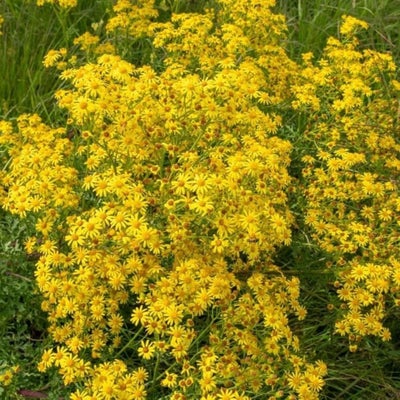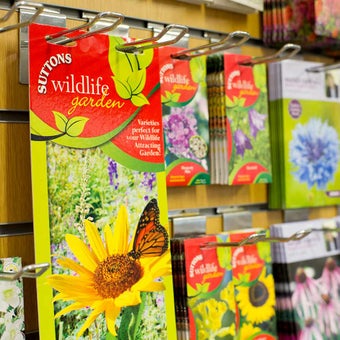
Quick facts
Common ragwort’s botanical name is Jacobaea vulgaris; it is also known by the synonym Senecio jacobaea
Its common names include benweed, cankerweed, stinking willy and yellowtops
A UK native wildflower, ragwort is a valuable plant for wildlife, particularly pollinating insects
Ragwort is poisonous to horses and livestock, and should be treated as a weed in gardens bordering grazing land or land used to grow forage
If you need to control ragwort, non-chemical methods are effective
What does ragwort look like?
Common ragwort , which mostly appear in autumn, initially have spade-shaped, wavy-edged, hairless leaves. In the first year of growth, they develop into an overwintering rosette of ‘feathery’, deeply-lobed, dark green leaves. Underground, the early branches into a network of thick, tough, pale roots.
In their second year, plants produce leafy, upright stems to 1.5m (ft) tall, though they are often much shorter. These are branched in the upper half and hold large, flat-topped clusters of yellow, daisy-like flowers from July to October. Seeds begin ripening in August and central ones have a thatch of hairs attached for wind dispersal, giving seedheads a fluffy appearance.
Common ragwort is usually , with plants dying after flowering, however they can become if the leafy rosette is damaged during the first year.

Common ragwort may be confused with other widespread ragwort species, particularly marsh ragwort (Jacobaea aquatica), hoary ragwort (J. erucifolia) and Oxford ragwort (Senecio squalidus). It can also resemble other tall, yellow wildflowers including tansy (Tanacetum vulgare), common fleabane (Pulicaria dysenterica), smooth hawk’s beard (Crepis capillaris) and goldilocks (Galatella linosyris). RHS members can use the Gardening Advice service for help identifying plants in their garden.
Is ragwort a weed?
Ragwort is a UK found throughout the country on grassland, sand dunes, pastures, verges and wasteland. It is a fantastic plant for wildlife, with more than 200 species of invertebrates recorded on it. Its flowers are attractive to a range of pollinating insects, including bees, butterflies and moths, and it is the primary food plant of caterpillars of the striking, day-flying cinnabar moth.


Despite its benefit to wildlife, ragwort is listed in the Weeds Act 1959, which exists to control the spread of plants considered problematic on agricultural land. Ragwort is included as it is poisonous to horses and other livestock. The ingestion of green or dried ragwort by grazing animals can cause serious liver damage and can be fatal.
It should be treated and controlled as a weed by those with gardens bordering grazing land or land used to grow forage. However, where it poses no risk to livestock, ragwort is an attractive and wildlife-friendly addition to the garden.
Be aware
Other species of ragwort, including marsh ragwort (Jacobaea aquatica), hoary ragwort (J. erucifolia), Oxford ragwort (Senecio squalidus) and the rarer fen ragwort (Jacobaea paludosa) are also toxic to horses and livestock. Though they are not included in the Weeds Act legislation, it is still good practice to control these species if they appear in your garden and could pose a poisoning risk.
Frequently asked questions about controlling ragwort
Here are our answers to your most common questions about dealing with ragwort:
How invasive is ragwort?
Ragwort plants produce many thousands of seeds, and its seed are adapted to ensure wide dispersal. Those in the centre of the flower head have a thatch of hair attached so they can be transported long distances by the wind, while those around the edge are heavier, with no hairs, and simply drop to the ground ready to germinate after the parent plant dies.
Ragwort can also regenerate from small sections of root and may be inadvertently spread by digging or moving soil.

Do I need to get rid of ragwort?
If your garden borders grazing land or land used to grow forage, or contains a paddock, then it is prudent to control ragwort. If you fail to control its spread, you could be served an order under the Weeds Act 1959 to do so. The Ragwort Control Act 2003 sets out a Code of Practice on preventing its spread and non-compliance with this can be used as evidence in legal proceedings.
However, in most gardens, where there is no risk of ragwort poisoning livestock, it is perfectly acceptable, and indeed very beneficial, to allow it to grow. Its attractive, pollinator-friendly flowers make it a welcome addition to wildflower meadows and flower-rich lawns and its presence boosts the of your garden.
What is the easiest way to kill ragwort?
The Code of Practice on preventing the spread of ragwort provides details on managing it in a variety of settings. For small populations in gardens, you have the following control options:
- Hoe off – do this promptly, in autumn and spring, before seedlings become established and able to regenerate from their roots. Hoe on a warm, dry or windy day so exposed roots dry out quickly.
- Smother seedlings – ragwort needs a light, open site for good and early growth, so mulching borders reduces germination and smothers emerging seedlings. For best results apply a 10cm (4in) thick layer of organic matter to your soil in autumn and spring. Alternatively, fill gaps in borders with ground cover plants.
- Pull or dig out plants – this is easiest when plants are in their first year of growth (just a rosette of leaves) and on loose soil or after heavy rainfall. Wear gloves and use your hands or a hand fork or trowel to remove small plants, and a border fork to remove larger ones. If removing mature plants (in their second year of growth), do so before they start seeding. Ragwort can regenerate from root fragments, so try to get as much of the root system out as possible. Remove any regrowth as soon as seen.
- Avoid cutting – cutting back ragwort should only be used where it is not feasible to remove plants by pulling or digging, or as an emergency measure to prevent seed spread. This is because ragwort responds to cutting with vigorous regrowth. Cutting early in the season encourages plants to adopt a habit, making control an ongoing task, while cutting later encourages reflowering.
- Avoid mowing – this chops up and spreads ragwort, making it harder for animals in neighbouring grazing land to identify and avoid it. It is also ineffective at controlling growth, as ragwort plants regrow from the remaining leafy rosette.

How should I dispose of ragwort?
It is important to dispose of ragwort carefully as cut or pulled flowering plants can still set seed, and all parts of the plant remain toxic, even if wilted or dried. Do not add ragwort flowers or seedheads to your home compost bin as it may not reach high enough temperatures to kill them. Instead, put them in your council green waste recycling bin or take them to your local recycling site.
If transporting ragwort, take care to cover the heads (with a reusable plastic bag, for example) to collect any loose seeds.
Should I use weedkiller?
No – as small populations of ragwort can be easily controlled using non-chemical methods, there is no need to use a weedkiller.
The RHS does not support the use of weedkillers and recommends that alternative control methods are used. However, we do note that when gardeners struggle to control plants with cultural methods, regulated weedkillers/pesticides for home gardeners are available for use legally. Garden centres and large retailers selling weedkillers have trained staff who can advise on suitable products for your needs.










